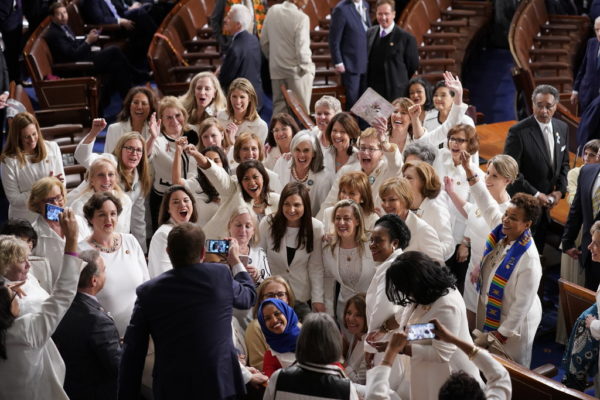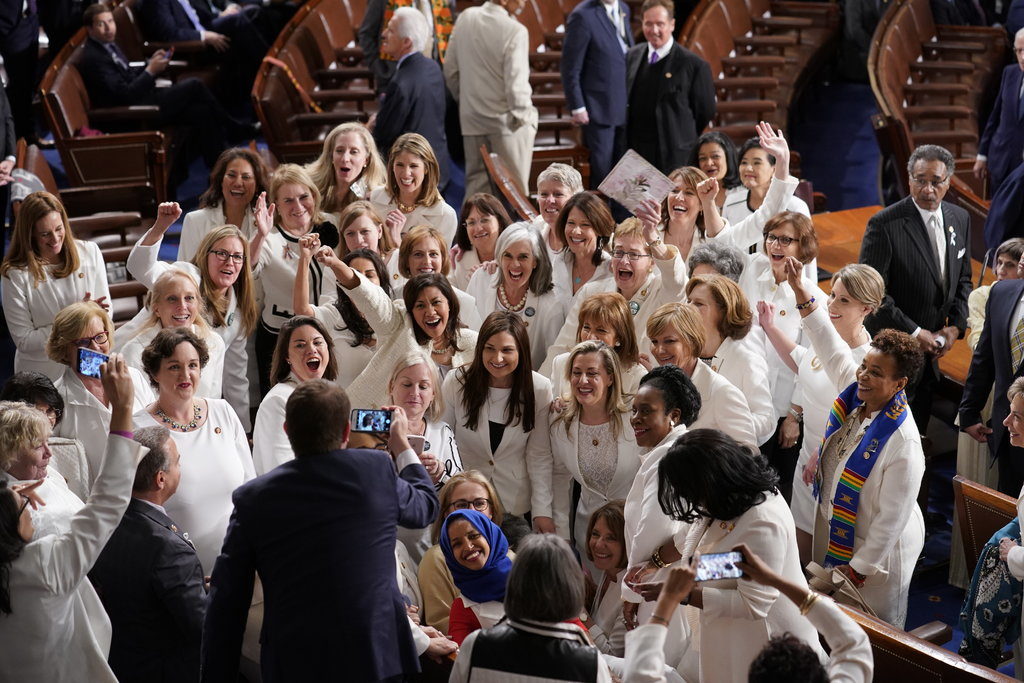Nuns Too

The irony does not escape me: On the day I’m writing this, the day after the State of the Union address, the two stories that interest me most on NPR and the BBC are about the speech and about the Pope’s acknowledgement that sisters have been sexually abused.
Looking at all those Congresswomen in white reminded me of the few white garments based on the Dominican habit in the Met “Heavenly Bodies” exhibit last year: how they stood out among the black and brown.

There were enough women in white in the Congressional chamber to make a strong statement about presence and power. Suffragists used the color to symbolize “purity of purpose,” an interpretation I like better than simple “purity.” Temperance campaigners wore white ribbons even earlier; maybe we could do that in solidarity with all the women who vote in Congress.
Or in solidarity with all nuns who have been abused by priests and bishops. At last. Out in the press, widely. I will stifle the rage I feel by looking at the sequence of events.
On February 1, Lucetta Scaraffia, the moving force behind Women Church World, a monthly supplement to L’Osservatore Romano, the Vatican newspaper, condemned “the sexual abuse of nuns by priests and the resulting ‘scandal’ of religious sisters having abortions or giving birth to children not recognized by their fathers,” according to the The Tablet. This attracted attention, as you can imagine. Scaraffia says nuns don’t report “for fear of retaliation,” and reminds us that last November, the International Union of Superiors General had condemned “those support the culture of silence and secrecy, often under the guide of ‘protection’ of an institution’s reputation or naming it as ‘part of one’s culture.”
Here is a problem. Sylvia Poggioli’s list of places where this abuse has been reported includes only two countries in the “global North”: Italy and France. All the rest are in the global South. Gail DeGeorge in a lengthy Global Sisters Report article in January documents many of these incidents. She also describes a presentation about sexual abuse and “grooming behaviors” of abusers developed by Rose Pacatte and other American sisters for the Major Superiors Leadership Conference in Pakistan, of all places. It’s so clever: visuals advising “Identify and Avoid.” “Don’t Give.” “Don’t Send.” “Don’t Ask.” It’s so concrete.
“Each community has to figure out how to present this information to their younger sisters without turning them off men or clergy — making them wise but not afraid,” said Pacatte. “We have to recognize [sexual abuse of sisters] is real and come up with a protocol if something does happen.”
This article did not get the attention that Scaraffia’s did, and I wonder if American feminists, in this case, nuns, will be criticized for attempting to override local cultures of gender relations.
The Pope seems to be on board. On the plane leaving the Arabian peninsula on February 5, Francis was asked numerous times about the issue Scaraffia had raised. His comments, as quoted by LaCroix International,have a simplicity that may not be only an effect of translation:
“It’s true, it’s a problem.”
“The slavery of women, including sexual slavery, had become part of it.”
“There have been priests and even bishops who have done that.”
“I would guess that it still happens today, because it is not something that ends just because people know about it.”
“We have been working on this for a while.”
“We have suspended some priests, sent them away for this, and — I’m not sure if the whole process had been completed — but we also have dissolved a few women’s religious congregations… Must more be done? Yes.”
I am so glad this issue is raised before the summit on sex abuse at the end of February. Worldwide bishops should be thinking not only of children; they need to consider nuns along with seminarians among the “vulnerable adults” who can be victims of clergy.
Which gets us to clericalism, the root cause of so many problems, as Scaraffia writes:
“If you point to power, to clericalism, the abuse against religious sisters takes on another aspect and can finally be recognised for what it is: that is an act of power in which touch becomes a violation of one’s personal intimacy.”
I could go on about this, too, but I won’t. I will merely draw you back to the State of the Union address.
Stacey Abrams spoke of the “uncommon grace of community” in the Democratic response. African Americans have relied on each other from slavery days to now. Women religious should find this strength in their communities as well, and we should all support them.

One Response
I am actually a former religious (23 years) who is married to a laicized priest. I’m sorry, but before I can support your cause, I MUST stand up for LAICIZED PRIESTS (READ:PUNISHED). Canonically, my husband may ONLY attend to a person dying in an accident. He may not be a Eucharistic Minister, teach in a Catholic School/University/Seminary, even proclaim the Word of God at Mass/Liturgy. Thank You, Jesus, for pastors who see his value and gifts, which for various reasons, he brought to the lay state rather than remain in the clerical state.